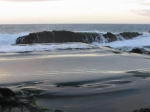The full moon glittered silver on the water as we gazed out to sea from the Santiago shore. Waves crashed in on the shingle, tumbling white foam and surging towards us. The Atlantic pulled back, sucking the water fast down shore, drawing back the rolling shingle, sending it racing downwards to the sea. Way above the horizon and out beyond the rough red cliffs we thought we could still make out snow on the peak of Mount Teide, across the sea on Tenerife. The wind that at sunset had torn at the date palms was gone and the scent of orange blossom floated in the warm night air.
Here on Gomera in the Canaries we have walked in easy companionship together. Once to the Guro waterfall, reached along a narrow gorge where a cat twitched its tail on a ledge high on the far gorge wall.
On a 6-hour trek we climbed 900m from the sea at Hermigua up the Cedro stream and past a reservoir with golden carp that tempted me to swim. Some islanders had lugged a cultivator up there to turn over the dusty soil. Even the remotest spot is turned to productive earth by the building of narrow terraces, irrigated from tanks of carefully stored water.
At the head of the valley, arum lilies grew along the stream banks. Tame goats gently butted us and a man emerging from his tent waved as we walked through the camp site for tea and ice cream.
We visited the island's only dragon tree, the blood red sap of which was collected because when hardened it could be used to make jewellery.
We picked our way through prickly pears once grown for cochineal beetles, and took shelter from the sun under Canary palms tapped for their syrupy sap. We walked in a sub-tropical rain forest of wax myrtle hung with moss. Agave, artemisia, asphodel, spurge, tree heather, cystus, small copper and brimstone: we learnt a new flora and fauna and began to appreciate the changing scents of the landscape. La Gomera, named after a grandson of Noah and visited by Columbus, claims more of its own species for each of its 378 sq km than anywhere else in Europe.
The Guanche were the island's indigenous people. Having long-forgotten the ways of the sea, they were powerless to stop the Spanish when they invaded. It is thought they retreated to the heights of Mount Garajonay. Close to the summit a few rocks remain of a religious site that faced out to the peak of Mount Teide on Tenerife, floating like some mystic, unattainable realm above cloud, far away across the sea.
We heard not a note of silbo, the Gomerans' unique whistling language that apparently allows them to communicate over kilometres. Under UN sponsorship it has been revived in the schools.

At dusk I swam in a man-made cold sea pool below great, grey cliffs at Hermigua. A man came took the trouble to walk down to warn me of high waves that would overtop the pool walls at any moment and risked carrying away my things.
We picnicked on Palma ham and quince jam sandwiches and in the evenings made meals for each other to Ella Fitzgerald at the cool, dark house we hired 1000m up on the edge of the national park. By the sea in Valle Grand Rey we ate out on fresh tuna, and at Lago Grande in Garajonay I devoured wild rabbit with red and green mojo sauce: one spicy, the other cooling. We covered ourselves in factor 60 because even in the breezes the sun still burnt.
On a barranco high above Vallehermoso we talked to an English couple that dreamed of making a tropical garden. They harvested cancer-beating berries from scrubby bushes in their garden and wondered if they had made the right decision leaving behind a farm in Sussex.
At the end of our holiday, late in the afternoon at the Playa del Ingles on the edge of Valle Grand Rey, we sat apart from each other for a while. A fierce wind blew as we watched 40 foot high waves breaking time after time against the sharp black basalt rocks.
On our last evening I picked an orange from the garden and Dona Efigenia gave us Gomeran bananas and bread for the journey home. At the airport on Tenerife a tall man in a cream suit lay dying on the terminal floor. His head lolled uselessly towards me as a paramedic pushed at his chest again and again and again.
Perhaps because of his death we missed the connection in Madrid. At dusk there I opened the triple-glazed window of the airport hotel and in the warm night air there was birdsong.



